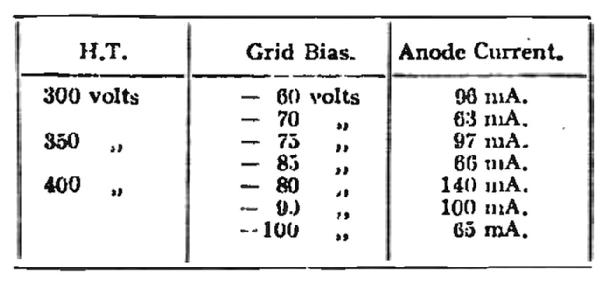Wireless World tested the Melodyne in July 1929.
Wireless World tested the Melodyne in July 1929.

Wireless World July 24, 1929. Page 82.
 A New Superpower Valve. The Mellodyne.
A New Superpower Valve. The Mellodyne.
This is a super-power output valve designed especially for use where a large electrical output is required to operate a number of loudspeakers. It is particularly suitable for use in the output position of a public-address amplifier; indeed, in slightly modified form, it is being employed in certain amplifying systems in connection with talking films and gramophone reproducing equipment. The main features of the valve are low A.C. resistance, comparatively high amplification factor, and exceptionally good mutual conductance. Furthermore, it operates without an excessively high anode potential.
This particular type is made by the North London Valve Co., Ltd., for Messrs. Pollock Bros., Royston Works, Putney, London, who have acquired the sole distributing rights.
The rated characteristics of the ' Mellodyne " are:
- A.C. resistance, 800 ohms
- Amplification factor, 3.8
- Mutual conductance 4.5 mA per volt.
This is an exceptionally good conductance for a valve of such low A.C. resistance. The normal working anode potential is 400 volts, and the optimum grid bias is of the order of minus 80 volts.

The construction of the valve differs widely from that generally adopted. Perhaps it can be described best as consisting of four sets of electrodes internally connected in parallel, but with a common anode.
The anode is divided into two compartments, however, and in each is assembled two grids and two filaments. The glass envelope measures 6” high by 3” in diameter, and the overall height is 8¼”.
The valve is not " gettered," but the required hard vacuum is obtained by pumping for a long period. Each valve is finally tested by running for a definite period with normal H.T. and zero grid bias, and at the end of this, it must pass satisfactorily a test for hardness before leaving the works.
The average characteristics under normal operating conditions of the specimen tested were found to be:
- A.C. resistance, 760 ohms
- Amplification factor, 3.3
- mutual conductance, 4.35 mA per volt.
These figures are sensibly in agreement with the maker's rating.
The following table gives the anode current under various operating conditions:—
In view of the low A.C. resistance and, comparatively, high amplification factor, special precautions must be adopted when using this valve. There may be a tendency towards incipient H.F. oscillation at a very high frequency, and should this occur, it will be traceable by a big increase in the anode current. Any tendency in this direction can be guarded against by fitting a resistance of a few thousand ohms in series with the grid. It would be advisable to regard this as an essential addition to the circuit, and it should be included as a precautionary measure.
The " Mellodyne " is being offered at £5 10s.
A valve of similar construction, but having an A.C. resistance of 1,000 ohms, an amplification factor of 4.6, and a mutual conductance of 4.6 mA. Per volt, is also available at the same price, but this particular type, known as " Leo the Lion," is supplied by the North London Valve Co., Ltd.
To thank the Author because you find the post helpful or well done.